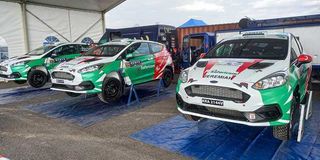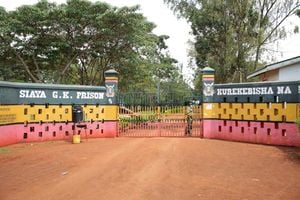Why changes to WRC will significantly reduce cost of purchasing rally cars

Rally cars belonging to Kenyan drivers Hamza Anwar, Jeremiah Wahome and McRae Kimathi being assembled at the Naivasha Service Park ahead of this week’s World Rally Championship Safari Rally which starts on Thursday.
What you need to know:
- Rally1 is a technical specification of rally car for use at the highest level of international rallying in the World Rally Championship (WRC) as determined by world motorsport governing body FIA
- Rallying is expensive, something FIA took into consideration when it introduced the Rally Pyramid in 2019
- Kenyan rallying reached its nadir in last year’s WRC Safari Rally when only four Kenyans competed in the main World Rally Championship Safari Rally
Cost is just one of the reasons the World Motor Sport Council discontinued the hybrid plug-in system in the Rally1 last month to open up the sport to more manufacturers, and to retain existing ones.
It is among the proposals adopted by the World Motor Sport Council on February 28.
The proposals had been made by a working group appointed by FIA late last year to propose changes aimed at making the World Rally Championship more attractive to stakeholders. The changes will be ratified in June.
Rally1 is a technical specification of rally car for use at the highest level of international rallying in the World Rally Championship (WRC) as determined by world motorsport governing body FIA.
Rally1 cars cost between Sh160 million and Sh190 million, and they are not for sale, although some manufacturers normally hire out or sell old models. With the changes, FIA now says these cars will probably cost about Sh63 million without the hybrid plug-in system which boosts power by more than 100 break horse power (bhp) to a maximum output of 514bhp. The hybrid plug-in system made cars as fast as Group cars of the mid 80s which were banned for being “too fast to race” as they had been causing many fatalities.
Only nine Rally 1 car models will compete in this year’s World Rally Championship Safari Rally premier league. Twelve cars have been entered in the second category known as Rally2, bringing together less powerful and sophisticated cars but by no means cheap. Only four Kenyans will be driving Rally 2 cars. They are Karan Patel, Carl Tundo, Aakif Virani and Samman Vohra.
The second-tier or Rally 2 car such as the Ford Fiesta of Africa champion Karan Patel will set one back by Sh18 million. The Rally 3 Ford Fiesta car retails at Sh9 million minus running cost and spares. This makes rallying very expensive and out of reach even for drivers in developed economies, unlike in the 90s and in the early 2000s when one could buy a used Subaru Impreza or Mitsubishi Lancer car, fit it with a roll cage, stiffen the suspension and competitively take part in rallying.
But Azar Anwar has a solution to closing this gap. He is for transforming a standard road going Toyota Yaris GR car into a mean machine which can hold its own against the much-specialised opposition from Ford or Hyundai.
Anwar has always been ahead of his time. He convinced Daewoo to enlarge its rally programme as he sought more collaboration with international tuning companies, noting that the South Korean rival Hyundai had taken cue and were secretly developing a local car to spice up competition locally.
Anwar believes that the period between 1995-2000 remains the golden era of rallying for local drivers, and a lost opportunity for Kenya to develop rallying into a self sustaining industry which might have offered the solution for the fledgling sport. Kenyan rallying reached its nadir in last year’s WRC Safari Rally when only four Kenyans competed in the main World Rally Championship Safari Rally.
Rallying is expensive, something FIA took into consideration when it introduced the Rally Pyramid in 2019. It is a collective description and organisation of championships, car performance classes and drivers aptitude in international rallying which can be simplified at regional events.
Rally 1 referes to the elite level of drivers’ aptitude and car performance in the WRC. Rally5, designed for cost effectiveness, is the entry point of rallying at the base. In between, there is Rally 2, 3, and 4, addressing potentiality and budgets.
For one always looking for opportunities and challenges, Anwar sniffed an opportunity in 2020 shortly after the Safari Rally returned to the World Rally Championship in 2019. He reached out to Toyota Gazoo Racing (TGR) in Japan with a proposal of buying two units of the Toyota Yaris GR production cars so as to develop them into rally cars for budget drivers in the Safari Rally, especially those on low budgets.
The Safari was returning back to the WRC, facing a completely overhauled championship with its own rules. Although motorsports remained active with an extremely competitive national championship which rivaled even established series in Europe as Onkar Rai, Karan Patel and Carl Tundo demonstrated by placing seventh, eighth and ninth in WRC Safari Rally 2021, majority of Kenyans did not have eligible cars to score points in the main WRC.
The Subarus and Mitsubishis prevalent in the national championships are of outdated technology. Their homologation certification expired in 2012, and although they keep on being renewed, they cannot compete in the WRC category, the reason we had the national championship category of the Safari.
But on a straight line, the pace of the cars obviously betrayed the authenticity of their industrial life span.
Buoyed by the success of the Daewoo and later Mitsubishi Lancer development projects, Anwar convinced TGR to provide him with the nibble but extremely fast Gazoo Racing (GR) road-going Yaris which was not available for sale easily especially in Africa at the turn of the decade.
Convinced and satisfied with his CV dating back to 1995, TGR jumped the waiting buying list and availed the car to Anwar who went to work of actually making structural changes on the car to meet the rigours of the WRC Safari.
“The GR Yaris is a1.6-litre three-cylinder turbo engine producing 257bhp and 360Nm propelling the little car from 0-100kph in 5.5 seconds which is enough and all one needs to be competitive in the Safari,” said Anwar.
“The purpose-designed platform with low centre of gravity and highly rigid, optimally balanced chassis offers a driving experience which is thrilling. I have modified the struts, suspensions, body shell and developed suspension settings and fitted it with a FIA roll cage.”
He said that he shares all these tech details with TGR and had wanted to develop the car further by being the route opener of the WRC Safari Rally.
“But this is a very expensive undertaking because I would be doing the entire Safari Rally in rally speeds regardless of the costs,” he says.
But he is already gasping for air after paying for the car, duty and spare parts. But he has not given up. This is a project which, besides offering a solution to increased participation, can also become affordable through economies of scale.
Without duty exemption from Kenya Revenue Authority, which is traditionally extended to rally cars provided they competed in the Safari Rally for three years previously, his efforts could offer Kenyans an affordable Kenya-tuned car of less than Sh8 million, which can also be sold to regional and continental drivers. It is a business opportunity worth trying, Anwar felt, for various reasons.
“I am an old hand in mechanical engineering but I feel old school when I meet young Kenyans operating their own garages. Oh boy! They are so good that they can modify an ordinary production car into a fire-spitting monster using digital technology. I believe by roping them in Kenya can become an exporter of technology mostly to the rest of Africa.”




